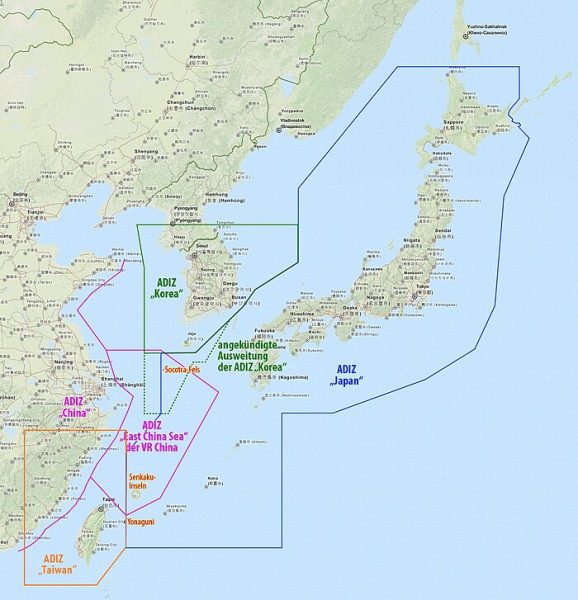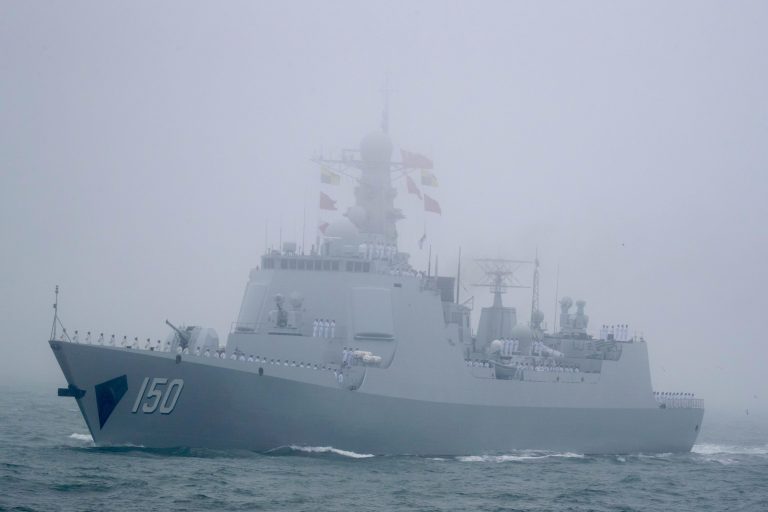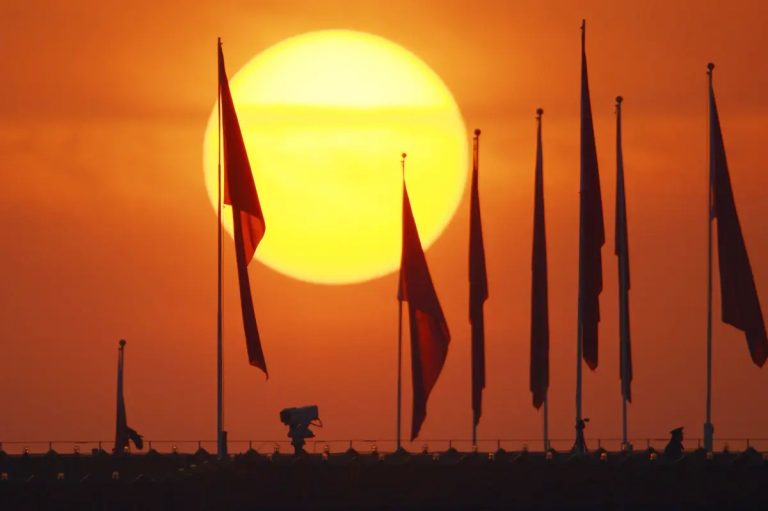By Li Jiaqi, Vision Times Staff
Observing the continuous presence of Communist Chinese warships in and around the Taiwan Strait in recent years, various experts expressed their belief that these deployments are aimed at not just the possibility of subduing Taiwan, but also warding off or engaging intervening forces from other countries.
In the event that the Chinese Communist Party (CCP) decides to invade or blockade Taiwan, Beijing would risk conflict with the United States as well as its allies, such as Japan or Australia, which possess sizeable air and naval forces.
On Jan. 29, Japan’s Yomiuri Shimbun ran an article noting the communist People’s Liberation Army’s (PLA) near-constant deployment of four warships at as many endpoints in the waters around Taiwan since August 2022, when then-U.S. Speaker of the House Nancy Pelosi visited the democratically governed island.
By maintaining a naval presence in the Taiwan Strait and east of the island itself, the PLA exerts continuous pressure on the Taiwanese military from multiple directions. The ships also form a screen between Taiwan and islands administered by Japan, which would complicate efforts to support Taiwan by friendly countries in a hypothetical war.
Anti-access/area denial
Success
You are now signed up for our newsletter
Success
Check your email to complete sign up
Taiwan and it surrounding islands form the last territory of the Republic of China (ROC), which was defeated on the Chinese mainland in 1949 by the CCP following a decades-long civil war. Beijing thus claims Taiwan as an inalienable part of its communist “People’s Republic.”
Off the northeastern coast of Taiwan lie the Senkaku islands, which are governed by Japan but claimed by both Beijing and Taiwan as the Diaoyu islands.
In November 2013, the People’s Republic of China (PRC) unilaterally declared the establishment of an East China Sea Air Defense Identification Zone (ADIZ), which included the Diaoyu Islands and overlapped with Japan’s own ADIZ.
READ MORE
- CCP Sends 39 Aircraft and Vessels to Harass Taiwan During Talks With Washington
- US Navy Sends First Warship Through Taiwan Strait Post-Election

Currently, at least three warships are routinely deployed in the border areas of the East China Sea ADIZ, and the PLA naval presence surrounds the Diaoyu islands, the Yomiuri Shimbun cited Japanese officials as saying.
Such deployment have persisted since around 2020, and are intended to deter U.S. and Japanese intervention in the event of a crisis in the Taiwan Strait.
The Japanese paper also noted that the PLA is strengthening its “Anti-Access/Area Denial” (A2AD) strategy to prevent the U.S. military from entering the inner side of the “First Island Chain,” connecting the southwestern islands of Japan and the Philippines. Mainland Chinese warships are routinely deployed in the border areas of the East China Sea ADIZ and the waters east of Taiwan, aligning closely with the aforementioned strategy.
‘If Taiwan is in danger, Japan is in danger’
Yoji Koda, a former vice-admiral in the Japanese Maritime Self-Defense Force, stressed in comments to the Yomiuri Shimbun that should Japan show any vulnerabilities in its defense, the CCP would likely target the Senkaku islands in conjunction with a military conflict over Taiwan.
Speaking with Radio Taiwan Intl on Jan. 30, Wang Zhisheng, assistant professor at the ROC Central Police University and director of the Contemporary Japan Research Association, analyzed that if the CCP “decides that it will attack Taiwan today, it will definitely engage in anti-intervention operations” targeting the Japanese and U.S. forces in the Senkaku and Ryukyu islands, which include Okinawa.
“If Taiwan is in danger, Japan is in danger,” Wang said.
The sentiment is one shared by Shinzo Abe, the late former prime minister of Japan. Abe, who led Japan for over a decade until 2020, emphasized the importance of supporting Taiwan.
Retired ROC Navy Captain Lu Lishi mentioned in recent comments with Taiwan’s China Times that during the 7th joint strategic air patrol by China and Russia, the range of activity extended to the vicinity of the East China Sea ADIZ. Russian warships also passed through the waters off Hualien, eastern Taiwan, on Jan. 26, indicating the possibility of future joint operational exercises between the two countries.
Lin Yingyou, Assistant Professor with the Graduate Institute of International Affairs and Strategic Studies at Tamkang University in Taipei, believes that the CCP would aim to militarily prevent any U.S. or Japanese intervention as part of an invasion of Taiwan.
With the victory of Lai Ching-te in the Jan. 13 Taiwan presidential election, it is widely expected that Taipei will pursue a path that does not yield to pressure from the CCP. Lai’s party, the Democratic Progressive Party (DPP), seeks to distance Taiwan from mainland China and build up the ROC as a more active international actor.
A protracted struggle
Recently, Japan’s Nikkei Asia invited former chairman of the Taiwan–Japan Relations Association Chiu Yi-jen; Professor Tomoki Kamo of Keio University in Tokyo; Kent Calder, Vice Dean of the Johns Hopkins School of Advanced International Studies (SAIS); and Professor Shi Yinhong with Beijing’s Renmin University to discuss the situation in the Taiwan Strait.
Calder noted that while the PLA may continue military exercises around the Taiwan Strait, more aggressive operations are unlikely due to mainland China’s severe economic downturn and its urgent need to court foreign investment.
- Beijing Deploys Spy Balloons Over Taiwan, Escalating Tensions Ahead of Key Elections
- The Collapse of Evergrande: A Symbol of China’s Deepening Property Crisis, Flailing Economy
While PRC leader Xi Jinping may be waiting for an opportunity to change the status quo, he is currently hard-pressed to do so, Calder added, unless Taiwan actively tries to declare formal independence from China.
Meanwhile, the choice of Hsiao Bi-khim as Lai Ching-te’s vice president, helps Taiwan strengthen its strategic cooperation with Washington, as Hsiao previously served as the ROC’s representative in the United States. The Lai-Hsiao administration takes office on May 20.
Shi Yinhong, the Renmin University professor, believes that the CCP will continue its attempts to build friendly relations with the opposition Kuomintang and Taiwan People’s Party (TPP) as long as the DPP cannot secure a majority in the ROC Legislative Yuan. Meanwhile, Beijing will continue to exert political, military, and economic pressure on the Lai administration.
According to Calder, a victory by Donald Trump in the upcoming U.S. presidential election this November would likely result in a more hardline stance on the CCP, which could lead to Washington shifting its policy of “strategic ambiguity” on Taiwan wherein it has not supported or rejected the ROC’s status as an independent state.
Shi added that Beijing will neither renounce the use of force against Taiwan, not stop attempts to pressure the ROC into “reunification” under the Communist Party.
Following Lai Ching-te’s election, the Pacific island nation of Nauru announced the termination of diplomatic relations with Taiwan and officially recognized the PRC.
Currently, just 12 countries recognize the ROC, and Beijing can be expected to keep exploring means of getting them to sever ties with Taiwan and switch their recognition to Communist China.
















